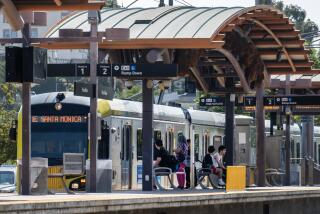Safe Rides for Young Drinkers: ‘We’re Getting Teens Home, and That’s What Counts’
- Share via
It was after midnight. Cathy, 16, had been visiting a friend. She had a few beers and felt a little drunk and tired and needed a way to get home.
To the rescue came Jenny Fitzpatrick and John Snakenborg of the Safe Rides program, who picked Cathy up in Snakenborg’s old Pontiac and took the Manhattan Beach girl home.
About 80 teen-age volunteers have signed up for the program, which provides rides for young people who have too much to drink on Friday and Saturday nights. The volunteers, who drive, dispatch cars and assist youths who are too drunk to handle themselves, usually work a couple of weekend nights per month out of the Hermosa Beach Community Center. Katrina Hammons, program assistant, said Safe Rides serves 10 to 15 teen-agers a night with two drivers, two riders and a dispatcher.
By calling 374-CARE, an intoxicated adolescent can receive a ride to locations in Hermosa Beach, Manhattan Beach, Redondo Beach, the Palos Verdes Peninsula and Torrance. Hammons said plans are being made to expand Safe Rides into Gardena.
But before the expansion happens, Safe Rides must solve its money problems. The program has been in existence since 1983, when the South Bay Free Clinic received a three-year, $96,000 grant from the California Office of Traffic Safety.
The original grant has expired, however. The Torrance City Council, through the Torrance Human Resources Commission, has provided $3,500 to keep the program going, but that is expected to run out in mid-May.
“If we don’t get other funding, it will cease,” Hammons said.
Regina Kodimer, executive director of the clinic, said Safe Rides applied for Proposition A transit tax funds, but was turned down by the Los Angeles County Public Transportation Commission, partly because it was considered a mobile counseling program rather than a transportation program.
Although staffed mostly by volunteers, Safe Rides needs money for gas and snacks and to pay an executive director.
Safe Rides asked the American Honda Foundation for a $20,000 endowment but the foundation, which awards grants to nonprofit social services, turned down the request on April 21 because the service is too localized. A spokesman for the foundation said grants are awarded to programs that are national in scope.
Safe Rides is an outgrowth of the Free Clinic’s Teen Advocate Program, where adolescents serve as peer counselors on such matters as birth control, alcoholism and drug abuse. Many Teen Advocates also work for Safe Rides.
Police applaud the program and credit it for reducing juvenile drunk-driving arrests. They do not believe that the availability of a ride home encourages youths to drink.
“A juvenile is going to drink anyway, and I don’t think knowing Safe Rides is there will influence them,” said Andy Harrod, community relations officer for the Manhattan Beach police.
“Some people think we’re saying it’s OK for teens to drink, but that’s not so,” said Fitzpatrick, 15, who attends South High School in Torrance. “We’re not accepting it (drinking), but we’re getting teens home, and that’s what counts.”
Harrod, who works with Safe Rides, said he believes that teen-agers drink because of peer pressure.
“They go out and socialize--one thing leads to another. It doesn’t take that much to become intoxicated, and before you know it, they’re drunk.”
Harrod said the program is effective for those who use it, but “trying to get the word out to other kids has been very difficult.”
Cathy, the tipsy teen-ager from Manhattan Beach, said she heard about the program at her school, Pacific Shores High. “I think it is definitely a good program because it encourages people to be safe when they drink.”
While not all teen-agers use it, the volunteers say they are pleased with Safe Rides. Fitzpatrick said she enjoys volunteering because she helps others and gets to know different types of people.
Karin Muenzer, 17, said she volunteered for Safe Rides because her favorite aunt was killed by a drunk driver. The Manhattan Beach resident wanted to keep the same thing from happening to others.
“I’m pretty optimistic,” Muenzer said. “I can’t really picture what this area would be without it. From being a driver, I see how much good we’re doing.”
Snakenborg, a 17-year-old student at Torrance’s West High School, was motivated to join after hearing a Teen Advocate speaker in one of his classes.
“I’ve gained great awareness of teen drinking and driving,” Snakenborg said. “I’ve seen how much of an impact I can make by doing this.”
He said Safe Rides users do not usually put up a fight, but some do. “I’ve taken people’s car keys away and told them, ‘You’re going to sleep here,’ or I’ve driven them home.”
As for the possible demise of Safe Rides, Snakenborg said, “If the program died, you would get more drunk teen-agers driving, and the awareness level would go down.”
Although most of the work is done by teen-agers, an adult is at the community center with them.
Fitzpatrick’s mother, Eileen Cross, 37, got involved with the program by accident. “I thought it was an adult program, but I realized it was a kid program. I felt like Mrs. Robinson,” she said, referring to a character in the movie “The Graduate.”
“But I stuck it out.”
She said the adults do not do much. “I just stay in the corner and drink my club soda.”
More to Read
Sign up for Essential California
The most important California stories and recommendations in your inbox every morning.
You may occasionally receive promotional content from the Los Angeles Times.













